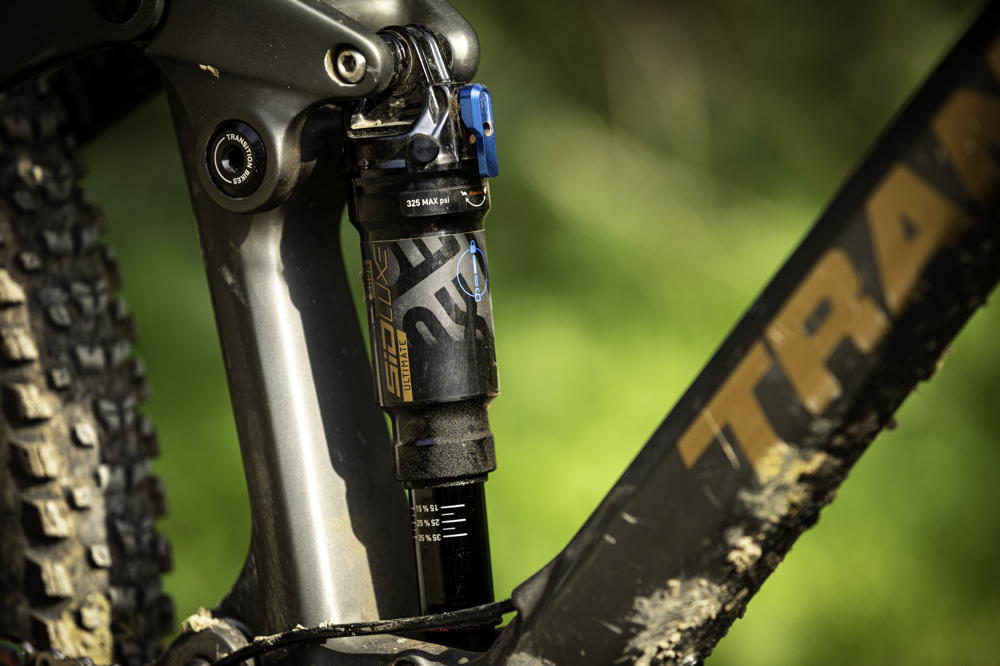Transition Spur joins the downcountry mountain bike wave. Sporting modest amounts of suspension travel but not shying away from aggressive geometry.
Transition Spur X01 review
Editor’s Choice 2020
Lightweight and capable are two words seldom used to describe a single bike. But the Transition Spur isn’t easy to classify, even if it is single handedly defining the emerging down-country segment.
Weighing a scant 11.25kg (24.8lb) the 120mm travel Spur is as light as most modern full suspension XC bikes, employing the world cup winning RockShox Sid fork and shock to save precious grams. Yet, with geometry and sizing to match a race-ready enduro rig, the Spur manages to unite two very distinct disciplines within mountain biking.
The common denominator that allows the Spur to seamlessly straddle both camps? In a word…speed. Up or down the Spur is lightning fast. Stomp on the pedals and the bike’s modified Giddy Up suspension design, that swaps the traditional Horst link pivot for flex stays, has you up to speed in the blink of an eye. The rear suspension is surprisingly planted on rough terrain too, which in turn gives the rider the confidence to press ahead and make full use of the pregressive geometry and sizing.
And while flex stay designs are as old as mountain biking itself, as is the idea of having a bike that climbs like an XC rig and descends like a downhill bike, the Transition is probably the only brand in history to have pulled it off both successfully. Is it any wonder that everyone who’s ridden the Spur wants to keep hold of it.

Transition Spur joins the downcountry mountain bike wave. Sporting modest amounts of suspension travel but not shying away from aggressive geometry.
Read more: Best short-travel ‘down-country’ bikes
Don’t be fooled by Transition’s hip, rider-owned company image. It’s a serious brand; the new 120mm Spur as cutting edge as it gets. Design language, pivot hardware and frame finish on this 29er all match the top brands.
It looks stunning too, a continuous line stretching from the dropout to headtube makes it look fast, but it also ensures the Spur avoids bodily contact no matter how hard you throw it around. In fact, Transition’s new rig is so sleek, you might struggle to notice the brand’s Giddy Up suspension design, where flexible carbon stays do the job of a heavier Horst-link pivot on the chainstay.
Transition Spur review
The RockShox SID fork is exceptionally light, but it also offers excellent support so it never dives straight through its 120mm travel. And much to our surprise the slimmer damper feels more supple and active than on a Pike. To weigh in at an impressive 1,600g, the SID chassis has been stripped to the bare bones, but it can still be pushed way harder than any other XC fork before it starts to feel overwhelmed.
Out back, the slender SIDLuxe rear shock is also a revelation in terms of control and stability. Like the fork, dials are minimised to save weight, but the shock still packs a working lock-out and good tuning potential. Staying power wasn’t an issue on the vast majority of UK descents either, so we had zero issues with the damping fading or unpredictability with the SIDLuxe.

SID fork is seriously svelte but silky smooth
Components
It feels a little odd to call value on a £6k bike, but Transition’s competitive pricing deserves serious kudos for the incredibly lightweight kit, given that the Spur retains the capacity to scare, then save you, even on chunky terrain.
Narrower, 25mm internal width, DT Swiss XR 1700 wheels come clad with rapid Maxxis rubber and the wheels feel fast, stiff and accurate enough for the most violent cornering. Yes, you can easily overstep the limits of the Rekon rear tyre, and more time spent on the newer Dissector upfront highlights the Rekon’s abrupt transition from central to side knobs when cornering hard.

Pared-down SIDLuxe shock still irons out the creases
Guide G2 RSC disc brakes have a firm but gentle touch, but the gram-saving 160mm rear rotor lasted two days on steeper trails before it was cooked and discoloured. And while we’ve never dropped a chain using a proper SRAM X-Sync II chainring, Transition’s jiggled off twice; likely a consequence of just how fast and hard you can charge on what is essentially an XC bike with vastly more stable geometry.

Transitin’s Giddy Up suspension system features flexible stays
Performance
Apply pressure to the Spur’s pedals and you can’t help but be impressed by the instant acceleration. It makes like Usain Bolt out of the blocks, catapulting you up the trail so quickly, you better get used to a constant earworm of ‘why do I ever drag a 160mm bike around?’.
Rapier-quick and precise also extends to the handling, since the ultra-low weight allows direction changes with the slightest shift in rider position. The relaxed 65.5° head angle and long wheelbase ensure a healthy dose of stability too, so the ride isn’t overly hectic either. To top it off, the Spur has so much grip and traction it never bites back unexpectedly, even when you deserve a nip. In fact, the only chink in the Spur’s armour is that when faced with heavy braking or heavier riders, you can notice some flex in the frame; something that’s totally at odds with how taut, sinuous and sharp it feels in every other situation.
It’s quiet and calm, and feels incredible hauling at full speed because you can focus so far ahead. Both wheels trace the floor with a graceful glide like an arcade air hockey machine, and, once you realise the 11.25kg (24.8lb) Transition Spur is more solid than the scales suggest, and can and will react to your intentions, you’ll be absolutely buzzing along rough singletrack trails, unless of course they’re fall-line steep.

What’s new for 2021?
Given that the Transition Spur isn’t even six months old, we don’t expect to see any updates until mid 2021 at the earliest. And even then, we’d be surprised to see anything more than some subtle changes to the specification or possibly some new frame colours. So if you’re in the market for a down-country bike that absolutely nails the brief, and are lucky enough to have £6k (£5k for the GX-equipped model) burning a hole in your pocket, the Spur should be top of your list.
Verdict
Transition’s Spur XO1 is the best-realised ‘down-country’ bike we’ve ever tested. It’s lightning quick, lures you right into the middle of a tornado of action, yet always spits you out with a sunshine-after-the-storm calmness wondering what all the fuss was about. Sure the lightweight Spur package can flex, and its diet kit gets a serious workout given hard you can push this bike, but the minimal mass and flightiness are pivotal to what makes it so great. So, while you could add stiffness and increase the descending capability further with meatier brakes, tyres or a beefier fork, that would pull the plug on such an electrifying, razor-sharp ride.
















